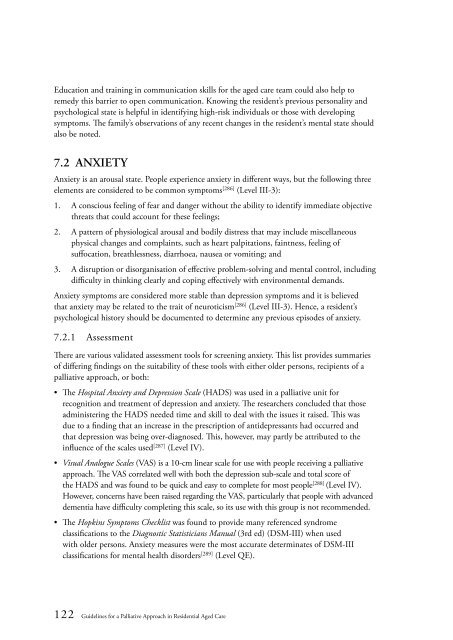Guidelines for a Palliative Approach in Residential Aged Care
Guidelines for a Palliative Approach in Residential Aged Care
Guidelines for a Palliative Approach in Residential Aged Care
You also want an ePaper? Increase the reach of your titles
YUMPU automatically turns print PDFs into web optimized ePapers that Google loves.
Education and tra<strong>in</strong><strong>in</strong>g <strong>in</strong> communication skills <strong>for</strong> the aged care team could also help to<br />
remedy this barrier to open communication. Know<strong>in</strong>g the resident’s previous personality and<br />
psychological state is helpful <strong>in</strong> identify<strong>in</strong>g high-risk <strong>in</strong>dividuals or those with develop<strong>in</strong>g<br />
symptoms. The family’s observations of any recent changes <strong>in</strong> the resident’s mental state should<br />
also be noted.<br />
7.2 ANXIETY<br />
Anxiety is an arousal state. People experience anxiety <strong>in</strong> different ways, but the follow<strong>in</strong>g three<br />
elements are considered to be common symptoms [286] (Level III-3):<br />
1. A conscious feel<strong>in</strong>g of fear and danger without the ability to identify immediate objective<br />
threats that could account <strong>for</strong> these feel<strong>in</strong>gs;<br />
2. A pattern of physiological arousal and bodily distress that may <strong>in</strong>clude miscellaneous<br />
physical changes and compla<strong>in</strong>ts, such as heart palpitations, fa<strong>in</strong>tness, feel<strong>in</strong>g of<br />
suffocation, breathlessness, diarrhoea, nausea or vomit<strong>in</strong>g; and<br />
3. A disruption or disorganisation of effective problem-solv<strong>in</strong>g and mental control, <strong>in</strong>clud<strong>in</strong>g<br />
difficulty <strong>in</strong> th<strong>in</strong>k<strong>in</strong>g clearly and cop<strong>in</strong>g effectively with environmental demands.<br />
Anxiety symptoms are considered more stable than depression symptoms and it is believed<br />
that anxiety may be related to the trait of neuroticism [286] (Level III-3). Hence, a resident’s<br />
psychological history should be documented to determ<strong>in</strong>e any previous episodes of anxiety.<br />
7.2.1 Assessment<br />
There are various validated assessment tools <strong>for</strong> screen<strong>in</strong>g anxiety. This list provides summaries<br />
of differ<strong>in</strong>g f<strong>in</strong>d<strong>in</strong>gs on the suitability of these tools with either older persons, recipients of a<br />
palliative approach, or both:<br />
• The Hospital Anxiety and Depression Scale (HADS) was used <strong>in</strong> a palliative unit <strong>for</strong><br />
recognition and treatment of depression and anxiety. The researchers concluded that those<br />
adm<strong>in</strong>ister<strong>in</strong>g the HADS needed time and skill to deal with the issues it raised. This was<br />
due to a f<strong>in</strong>d<strong>in</strong>g that an <strong>in</strong>crease <strong>in</strong> the prescription of antidepressants had occurred and<br />
that depression was be<strong>in</strong>g over-diagnosed. This, however, may partly be attributed to the<br />
<strong>in</strong>fluence of the scales used [287] (Level IV).<br />
• Visual Analogue Scales (VAS) is a 10-cm l<strong>in</strong>ear scale <strong>for</strong> use with people receiv<strong>in</strong>g a palliative<br />
approach. The VAS correlated well with both the depression sub-scale and total score of<br />
the HADS and was found to be quick and easy to complete <strong>for</strong> most people [288] (Level IV).<br />
However, concerns have been raised regard<strong>in</strong>g the VAS, particularly that people with advanced<br />
dementia have difficulty complet<strong>in</strong>g this scale, so its use with this group is not recommended.<br />
• The Hopk<strong>in</strong>s Symptoms Checklist was found to provide many referenced syndrome<br />
classifications to the Diagnostic Statisticians Manual (3rd ed) (DSM-III) when used<br />
with older persons. Anxiety measures were the most accurate determ<strong>in</strong>ates of DSM-III<br />
classifications <strong>for</strong> mental health disorders [289] (Level QE).<br />
122 <strong>Guidel<strong>in</strong>es</strong> <strong>for</strong> a <strong>Palliative</strong> <strong>Approach</strong> <strong>in</strong> <strong>Residential</strong> <strong>Aged</strong> <strong>Care</strong>
















